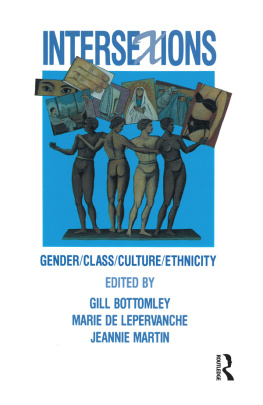
Kinds Come First
Kinds Come First
Age, Gender, Class, and Ethnicity Give Meaning to Measures
Jerome Kagan
The MIT Press
Cambridge, Massachusetts
London, England
2019 Massachusetts Institute of Technology
All rights reserved. No part of this book may be reproduced in any form by any electronic or mechanical means (including photocopying, recording, or information storage and retrieval) without permission in writing from the publisher.
Library of Congress Cataloging-in-Publication Data is available.
Names: Kagan, Jerome, author.
Title: Kinds come first : age, gender, class, and ethnicity give meaning to measures / Jerome Kagan.
Description: Cambridge, MA : MIT Press, [2019] | Includes bibliographical references and index.
Identifiers: LCCN 2018059566 | ISBN 9780262042932 (hardcover : alk. paper)
Subjects: LCSH: Life change events--Psychological aspects. | Life cycle, Human--Psychological aspects. | Social classes--Psychological aspects. | Ethnicity--Psychological aspects. | Gender--Psychological aspects. | Social psychology.
Classification: LCC BF637.L53 K34 2019 | DDC 158.1--dc23 LC record available at https://lccn.loc.gov/2018059566
10 9 8 7 6 5 4 3 2 1
d_r0
Contents
The primary theme of this slim book is easy to state: It is a critique of the popular premise that a particular value on a reliable measure probably possesses the same theoretical meaning for human participants who vary in developmental stage, gender, social class, or ethnic group. The health consequences of a behavior, say excessive drinking of wine, beer, or whiskey, are ambiguous because the level of risk usually depends on the life stage, gender, class, and ethnicity of the person. Nonetheless, one research team ignored these categories when they reported that anyone who drank more than 100 grams of alcohol per week (more than seven glasses of wine) were at a higher risk for a serious illness (Wood et al., 2018).
Statements about popular psychological constructs, such as attention, anxiety, learning, memory, or regulation, are often silent on the subjects who provided the observations. The assumption that most psychological measures have meanings that transcend the kinds of agents providing the values reflects a premature hope of discovering broadly generalizable conclusions that apply to diverse animal species, as well as human participants who vary in life stage, gender, class, and ethnicity. This book questions the validity of this ambitious idea. I hope to persuade investigators to question their resistance to acknowledging that the meaning of many measures on human participants varies as a function of the above categories.
Most measures have considerable inter-individual variation, partly because an individuals developmental stage, gender, class, and ethnicity affect the probability that a skill, action, belief, or emotion will be displayed. Not surprisingly, each of those four categories makes its most significant contributions to different outcomes. Life-stage influences cognitive skills and regulation of impulse. Gender affects variation in the desire for signs of potency, the establishment of close relationships, and the quality of feeling tone. Social class position contributes to a persons sense of agency along with physical and mental health. Ethnicity creates conceptions of self as an insider or outsider in a society and is associated with genes that create temperamental biases. The chapters that follow defend these claims.
My failure to devote separate chapters to the contributions of culture, historical era, and religion was pragmatic. Most research on human behavior necessarily relies on individuals who live in this historical era. Second, the vast majority of studies of psychological outcomes are conducted on North American or European white adults who are either Christian or agnostic. The November 6, 2018, issue of Proceedings of the National Academy of Sciences contains a series of papers pointing to the robust differences between these populations and individuals from other groups. The plea to accept this fact had been made before but has had minimal success in changing practices. Perhaps this time will be different.
An insufficient body of reliable facts is the reason for the failure to devote time to extensive discussions of culture, history, and religion, although their contributions are not ignored. The American Psychiatric Associations decision in 1973 to remove homosexuality from the DSM-II list of mental disorders had profound consequences for many gay adults.
Interest in psychology was high in 1950, because many Americans were curious about the experiences that led to crime and mental illness. The 1950s was a decade of economic growth, peace in Europe, low unemployment, 30-cents-a-gallon gasoline, lower income inequality in comparison to our own era, and climate change, pollution, cyberattacks, and radioactive waste were not yet regarded as problems. Historical events over the past seven decades have catapulted these concerns to an alpha position in the minds of many Americans.
I suspect that some readers will object to the suggestion that combinations of age, gender, class, and ethnicity can make qualitatively distinct contributions to an outcome. They will insist that it is more useful to regard all healthy humans as differing quantitatively on a variety of continuous dimensions. This claim is valid when one examines individuals on a single dimension rather than on a pattern. Mice and humans differ quantitatively on many measures, including number of genes, brain weight, and longevity. But the two species are qualitatively distinct when we focus on the pattern of features that defines each kind.
The silver foxes that were selectively bred for tame behavior with humans in the Institute for Genetics in Novosibirsk, Russia, appear to represent a distinct category. Tame, compared with aggressive, male foxes possess a pattern that includes more serotonin receptors in the brain and distinctive levels of expression of 146 genes in the prefrontal cortex (Wang et al., 2018). The frequencies of biting the hand of a human who tried to touch a tame or wild fox form two almost non-overlapping distributions.
Of course, only humans care about this controversy. No lion broods over whether hyenas and gazelles vary quantitively or qualitatively. Humans, however, want to understand the causes of phenomena and their likely consequences. Both are more easily obtained if agents are treated as members of discrete categories. For example, nineteenth-century European clinicians classified all adults who possessed retarded language skills, compromised reasoning ability, and a limited short-term memory as varying quantitively on a dimension called feeble-minded. Contemporary physicians and psychologists classify these individuals into different groups, based on etiology and age of onset, and often prescribe different treatments for the members of each group. College-educated white women in the United States in 2018 are more likely than any other combination of gender, class, and ethnicity to enjoy equal status with males in marriage and occupational opportunities.
Life stage, gender, class, and ethnicity combined with an investigators measures form distinctive patterns. Removal of one component of a pattern usually alters the function of the entity in a major way. Removal of years of education from the pattern that defines social class changes the correlates of class. Removal of one of the sex hormones from the pattern that defines each gender has similar consequences. Although these differences affect the interpretations of evidence, they have minimal implications for social practices or legislation.
Next page









